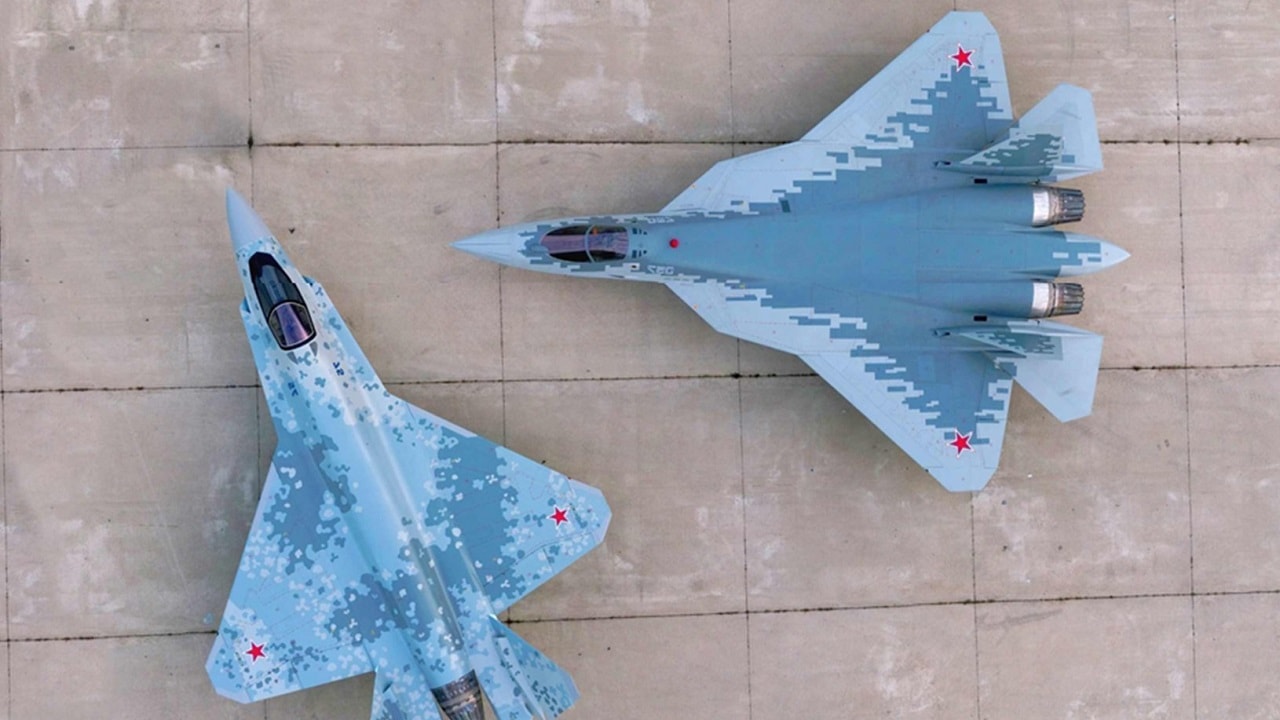Russia’s Su-75 Checkmate Fighter Is Playing a Slow Game – Can an airplane with the nickname Checkmate really win at the end? That’s the hope of a major Russian defense manufacturer – that the Su-75 planned stealth fighter can be a special product for export. Russian designers have resorted to a sparkly marketing campaign to hype the fighter, even going as far as bottling Checkmate perfume to wow the crowds at an air show.
But due to Western financial sanctions and export restrictions, this airplane may not be ready for several years and the ensuing delay will disappoint the government. And, in fact, the stealth fighter may never actually fly.
Su-75: When Will It Fly?
Last month, the director of defense contractor Rostec, told Vladimir Putin the new fighter would not be ready until 2027 – two years later than the last promise. Russia’s defense industry is known for over-promising and under-delivering, despite Putin’s usual bombast about new defense weaponry coming to the forefront.
Su-75 Foreign Sales to Drive Budget
The Checkmate program is wagering that the future airplane will get enough foreign orders that the money fronted from sales will pay for the project.
Analysts at the RAND Corporation believe this may not be a winning formula as Russia is hawking it abroad without disclosing any paying customers. One interested party could be India, whose government has remained neutral and non-aligned during the war in Ukraine. This means that India could be receptive to a Su-75 purchase. But Russia will need more than one customer for the planned airplane.
Could They Make It Cheaper than the Competition?
One marketable aspect of Checkmate is its price.
The Russians believe it is the cheapest fifth-generation fighter for sale in the ballpark of $25 to $30 million each. If that price holds, maybe Vietnam and African nations could fork out the cost too. That number is likely a moving target that could rise since the airplane is already behind schedule. And that aforementioned price point may be just for a base model without the technological marvels in propulsion and avionics. Russia would also have to include training and spare parts for developing countries that may not have expertise in flying a next-generation fighter.
Su-75: Looking Like Vaporware
Will the Su-75 even become a next-generation fighter that will eventually fly missions?
There is a mockup that was unveiled last year in an air show. Currently, most Russian defense efforts are centered around Ukraine. Manufacturing is now focused on advanced guided missiles and new tanks. Sanctions are taking the air out of these efforts too.
Some Innovations Could Help It Evade Radar
The Su-75 is planned to have a range of around 1,800 miles at MACH 1.8 speed and might be able to carry 16,500 pounds of ordnance.
Somehow Rostec believes the Su-75 is seven times less expensive to maintain than an F-35, which is assuredly an over-optimistic claim.
Designers think the Su-75’s “ruddervator,” which combines the rudder and elevator to control pitch and yaw could make the airplane stealthier.
Will The Sales Strategy Work?
It’s interesting Russia’s defense contractors are willing to wade into international sales before the Su-75 is complete. They are taking a chance on the free market which is a departure from their usual authoritative brand of capitalism. This assumes the defense ministry will find a way to fund it despite a costly war that is sucking up time, money, resources, and most importantly, lives.
I don’t see the Su-75 Checkmate changing the military balance for Russia or whoever may buy it. It’s just a marketing concept right now. However, if it takes to the skies before 2030, it could be noteworthy. Since Russia is a pariah state, it is difficult to imagine countries buying it without blowback from the international community and accusations that its purchase would aid the Russian military-industrial complex.
Russia may have to do more than hand out bottles of perfume at air shows to close a sale. And that means the Su-75 might be doomed from the very start.
Now serving as 1945’s Defense and National Security Editor, Brent M. Eastwood, PhD, is the author of Humans, Machines, and Data: Future Trends in Warfare. He is an Emerging Threats expert and former U.S. Army Infantry officer. You can follow him on Twitter @BMEastwood.

